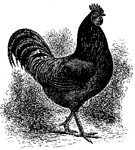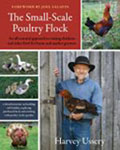
Breed Facts
Status:
Study
Use:
Eggs, Meat
Egg Color:
Tinted to Brown
Egg Size:
Medium to Large
Market Weight:
4 – 4.5 lbs
Temperament:
Active
Characteristics:
Exceptional free range bird with little supplement needed
MANX RUMPY OR PERSIAN RUMPLESS CHICKEN
Tailless fowl like the Manx Rumpy have been observed in many parts of the world and have a history going back hundreds, and possibly thousands, of years. The Italian naturalist, Ulisse Aldrovandi mentions Persian Rumpless fowl in his Ornithology published in 1600. The Reverend J. Clayton documented seeing rumples fowl in Virginia in 1693, but was unable to determine their origins. George Watson in his book, Farm Poultry (1903), writes that flocks of tailless fowls were to be found in New York and Pennsylvania and they were utilized as general-purpose fowls. Rumpless fowls were reported as existing in Africa and domesticated by both native Africans and the Boers. In Belgium we find the Walloon chicken, which is said to have existed in the countryside about Walloon and Seize since time immemorial. They are also said to have originally arrived from Ceylon. According to the poultry historian C.N. Bement, while found on Ceylon, rumples fowls were not wild and were in fact introduced from Cochin, China. Rumpless fowls are also to be found in Japan and in South America – particularly in Chile.
Rumplessness in chickens occurs when birds are missing the coccyx, or “Pope’s Nose”, from which the tail feathers emerge. This mutation is congenital and occurs from time to time in birds of all kinds. It is in inheritable, and in the case of chickens, may be caused by either a recessive or a dominant gene – the dominant gene being more common. In the United States, the only breeds of tailless fowl with any sort of documentable history of importation are the Araucana and the Persian Rumpless.
In 1958 Dr. Albert McGraw got a start of Persian Rumpless chickens from Al Caldwell. Cadwell had gotten his start in the breed from a relative living in California, who had a Persian (Iraqi) neighbor. This Persian neighbor’s family had had the birds for at least three generations. The Caldwell birds were thus Persian Rumpless chickens. Due to the small population, introductions of other breeds were made (Araucana, Hamburg, and others). These outcrosses produced even more variability in plumage, comb, and type, and created many birds whose phenotype were a good approximation of that for the Manx Rumpy, a completely unrelated chicken breed from the Isle of Man. The name “Manx Rumpy” was chosen for those chickens in reference to the famous tailless Manx cat found on that island as well. Over time, the name “Manx Rumpy” was inadvertently applied to many lines of tailless birds in America. As the original Manx Rumpy chicken breed from the Isle of Mann has never been known to have been imported into America, the American population should be referred to as Persian Rumpless.
It is interesting to note that Craig Russell, President of the Society for the Preservation of Poultry Antiquities, shared that the original Caldwell birds occurred in several colors, but were largely only of duckwing in color patterns. Early drawings of Persian Rumpless seem to complement this observation. Mr. Russell also remarked that in the Caldwell flock, the rumpless gene was recessive in nature. Dr. McGraw has also noted that the original birds had a “wild look” about the eyes. Dr. McGraw further has noted seeing flocks on TV during broadcasts from the “Desert Storm War” in 1991; these flocks were observed in footage filmed near Baghdad.
In size Persian Rumpless fowls vary greatly, but in the majority of birds the males will weigh from 5 to 6 lbs and the females from 4.5 to 5.5 lbs. Combs are usually single, though even old literature does mention the presence of rose type combs. Type should be decidedly game-like in nature – with muscular breasts and good width between the legs. While Persian Rumpless are a good deal “game” in nature, aggressiveness in a large flock is usually reserved for new roosters and roosters of different breeds. Persian Rumpless chickens are not recognized by the American Poultry Association.
You may be interested in…



